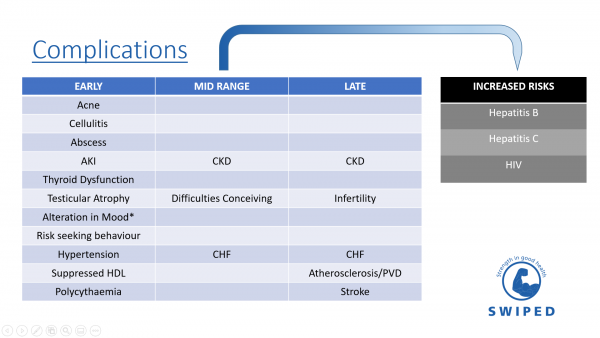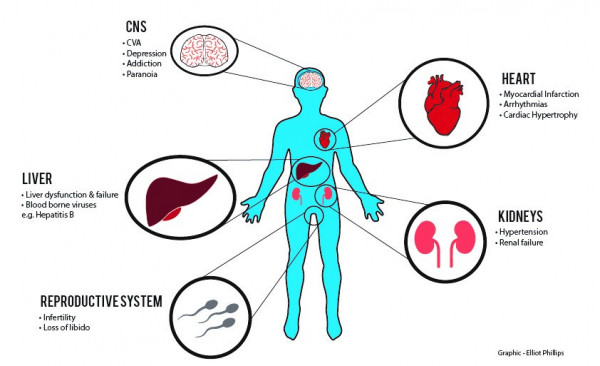Common Side-effects
IPEDs can cause a range of acute and chronic side effects that can be psychiatric or physiological. These can have a profound impact on the lifestyle and wellbeing of users.
Many users of IPEDs will combine different regimes of drugs, known as stacking. Different combinations and higher doses of IPEDs increases the likelihood of drug interactions and side effects. These side effects may have a greater long-term impact if taken by young people who are still developing.
The 2015 IPED survey found the most common side effects was pain at injection site (31% of men, 9.1% of women) and mood swings (26% of men, 32% of women). Pain at injection site also included infection and abscesses resulting from practices such as poor injection technique and sharing needles(37).
Anabolic steroids are the most commonly used IPED which are typically testosterone esters(34). These drugs interact with the hormonal axes of the body and lead to unwanted side effects such as male pattern baldness, gynaecomastia, infertility, testicular atrophy and hirsutism in females. These side effects are well-recognised by IPED users and can be off-putting.
Some synthetic derivatives of testosterone, such as Trenbolone, have a greater affinity with the testosterone receptors causing more of the unwanted androgenic side effects. In an effort to counteract unwanted effects, different steroids with a greater anabolic-to-androgenic effect are used. Users also commonly utilise a variety of other substances to combat these side-effects, such as Human Chorionic Gonadotrophin. hCG is taken under the belief it will restore normal hormonal axis function following anabolic steroid use.

Long term use of anabolic steroids is associated with a number of chronic health conditions and early mortality. These include liver damage, hypertension, cardiac arrhythmias and altered lipid metabolism, which increases the likelihood of MI, CVA and suppressed HDL giving rise to early atherosclerosis. As a direct result of steroid use, cardiac hypertrophy is also a possible(38).
IPEDs can have a profound impact on patients’ mental health, leading to conditions such as depression, paranoia, addiction (including to recreational drugs) and mood changes(30). As a result, IPED users are linked to increased rates of incarceration(39) and premature death not just from physical conditions, but also from suicide(40). The intrinsic effect IPEDs can have on mental health, in addition to possible pre-existing body dysmorphic disorders, can make it harder for users to engage in cessation even in the presence of potentially life-threatening side effects.
Testosterone has long been implicated in many of the risky behaviours exhibited in male adolescence. Increased serum testosterone has also been linked to increased risk-taking(41). This can take the form of gambling, speeding & dangerous driving or other unnecessary risks. As a result, IPED users may be less likely to appreciate the risks associated with IPED use as well as any deleterious behaviour.
A commonly held belief is an association between increased serum testosterone and physical aggression (colloquially “roid rage”)(42). Some research alludes to a link between anabolic steroid use and aggression, but acknowledges the limitations of such data(43). Aggression being more so linked to typically linked with those who are already demonstrating anti-social behaviour traits, and have a dependence on anabolic–androgenic steroid (AAS)(42,43). Some research whilst acknowledging a link between AAS use and aggression, questions if AAS use causes aggression or individuals who have tendency toward aggression seek out AAS? This remains unclear(44).
A number of other normally endogenous hormones are also used as IPEDs. Growth hormone has been used since the 80s as a doping agent to build muscle quicker and decrease the recovery time from sporting injuries. Excess exogenous growth hormone can result in acromegaly. This can present with symptoms such as fluid retention, enlarged hands, feet and jaw, arthralgia, and an increased risk of diabetes mellitus, cardiomyopathy and hypertension(45).
Another commonly used IPED is Insulin. As with diabetics, the major risk of exogenous insulin is hypoglycaemia(46), which can be life-threatening with many of the athletes taking it having insufficient education about risks & dosage. WADA are still unable to detect insulin doping which means the scale of the problem is unknown.
Risks of blood borne viruses in IPED users is increased. These are HIV, hepatitis B and hepatitis C (47)
A summary of IPEDs side effects on the body can be seen in figures 1 and 2.
Figure 1. Results of the 2015 survey into IPEDs. Commonly report side effects and their prevalence
|
|
Past Year n (%) |
|
|
Injury/Adverse Effect |
Males (n=638) |
Females (n=25) |
|
Pain at injection site |
174 (31) |
1 (9.1) |
|
Mood swings |
164 (26) |
8 (32) |
|
Testicular atrophy |
162 (25) |
- |
|
Increased aggression |
110 (17) |
2 (8) |
|
Raised BP |
91 (14) |
5 (20) |
|
Swelling/Redness at Injection site |
91 (16) |
2 (18) |
|
Gynaecomastia |
81 (13) |
- |
|
Unwanted facial/body hair |
37 (5.8) |
5 (20) |
|
Hair Loss |
35 (5.3) |
2 (8) |
|
Nausea |
37 (5.8) |
1 (4) |
|
Deepening voice |
27 (4.1) |
3 (12) |
|
Acne |
25 (2.4) |
1 (4) |
|
Abscess/Wound at injection site |
22 (2.1) |
0 |
Figure 2. Common long term side effects of IPEDs.


